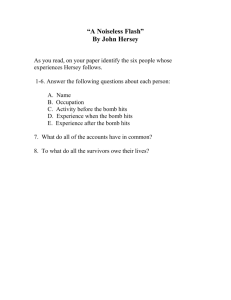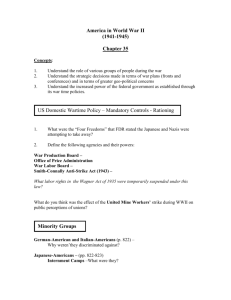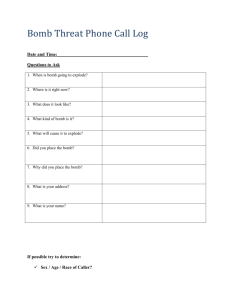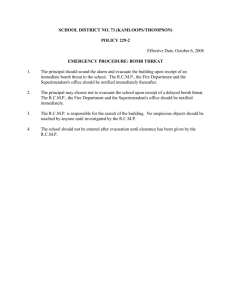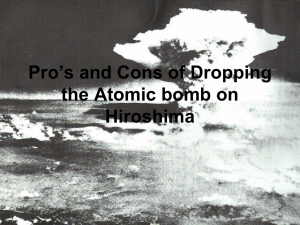CBA Example #1
advertisement
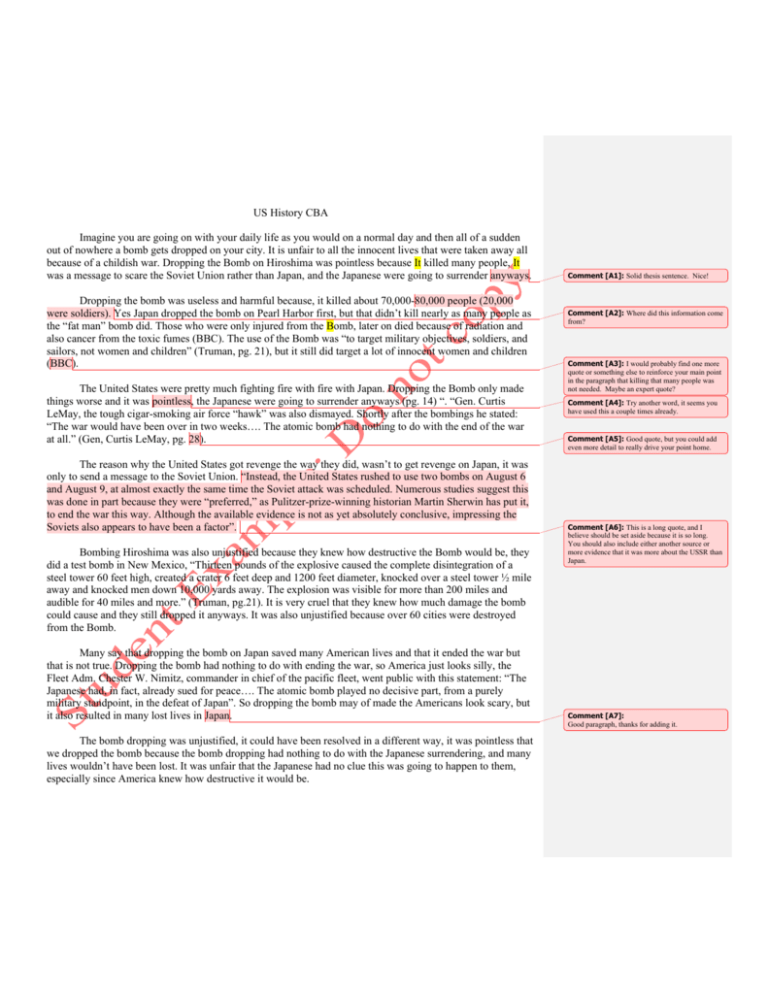
US History CBA Imagine you are going on with your daily life as you would on a normal day and then all of a sudden out of nowhere a bomb gets dropped on your city. It is unfair to all the innocent lives that were taken away all because of a childish war. Dropping the Bomb on Hiroshima was pointless because It killed many people, It was a message to scare the Soviet Union rather than Japan, and the Japanese were going to surrender anyways. Dropping the bomb was useless and harmful because, it killed about 70,000-80,000 people (20,000 were soldiers). Yes Japan dropped the bomb on Pearl Harbor first, but that didn’t kill nearly as many people as the “fat man” bomb did. Those who were only injured from the Bomb, later on died because of radiation and also cancer from the toxic fumes (BBC). The use of the Bomb was “to target military objectives, soldiers, and sailors, not women and children” (Truman, pg. 21), but it still did target a lot of innocent women and children (BBC). The United States were pretty much fighting fire with fire with Japan. Dropping the Bomb only made things worse and it was pointless, the Japanese were going to surrender anyways (pg. 14) “. “Gen. Curtis LeMay, the tough cigar-smoking air force “hawk” was also dismayed. Shortly after the bombings he stated: “The war would have been over in two weeks…. The atomic bomb had nothing to do with the end of the war at all.” (Gen, Curtis LeMay, pg. 28). The reason why the United States got revenge the way they did, wasn’t to get revenge on Japan, it was only to send a message to the Soviet Union. “Instead, the United States rushed to use two bombs on August 6 and August 9, at almost exactly the same time the Soviet attack was scheduled. Numerous studies suggest this was done in part because they were “preferred,” as Pulitzer-prize-winning historian Martin Sherwin has put it, to end the war this way. Although the available evidence is not as yet absolutely conclusive, impressing the Soviets also appears to have been a factor”. Bombing Hiroshima was also unjustified because they knew how destructive the Bomb would be, they did a test bomb in New Mexico, “Thirteen pounds of the explosive caused the complete disintegration of a steel tower 60 feet high, created a crater 6 feet deep and 1200 feet diameter, knocked over a steel tower ½ mile away and knocked men down 10,000 yards away. The explosion was visible for more than 200 miles and audible for 40 miles and more.” (Truman, pg.21). It is very cruel that they knew how much damage the bomb could cause and they still dropped it anyways. It was also unjustified because over 60 cities were destroyed from the Bomb. Many say that dropping the bomb on Japan saved many American lives and that it ended the war but that is not true. Dropping the bomb had nothing to do with ending the war, so America just looks silly, the Fleet Adm. Chester W. Nimitz, commander in chief of the pacific fleet, went public with this statement: “The Japanese had, in fact, already sued for peace…. The atomic bomb played no decisive part, from a purely military standpoint, in the defeat of Japan”. So dropping the bomb may of made the Americans look scary, but it also resulted in many lost lives in Japan. The bomb dropping was unjustified, it could have been resolved in a different way, it was pointless that we dropped the bomb because the bomb dropping had nothing to do with the Japanese surrendering, and many lives wouldn’t have been lost. It was unfair that the Japanese had no clue this was going to happen to them, especially since America knew how destructive it would be. Comment [A1]: Solid thesis sentence. Nice! Comment [A2]: Where did this information come from? Comment [A3]: I would probably find one more quote or something else to reinforce your main point in the paragraph that killing that many people was not needed. Maybe an expert quote? Comment [A4]: Try another word, it seems you have used this a couple times already. Comment [A5]: Good quote, but you could add even more detail to really drive your point home. Comment [A6]: This is a long quote, and I believe should be set aside because it is so long. You should also include either another source or more evidence that it was more about the USSR than Japan. Comment [A7]: Good paragraph, thanks for adding it. Works Cited Dietrich, Bill. "Pro and Con on Dropping the Bomb." The Seattle Times. The Seattle Times, n.d. Web. 07 Feb. 2013. Truman, Harry S. "Harry S. Truman, Diary, July 25, 1945." N.p., n.d. Web. 07 Feb. 2013 Wilmshurst, Paul. "Hiroshima." Hiroshima. BBC. BBC, 2005. Television MEETING STANDARD NOT MEETING STANDARD A- Position 5.4.1: Evaluates and interprets other points of view on an issue within a paper or presentation. B- Causes 1.31 Analyzes and evaluates the causes and effects of US foreign policy on people in the United States and across the world (1890-present) 4 - Excellent 3 - Proficient States a position on the chosen foreign policy that outlines reasons in support of the position AND Draws a conclusion about why studying this foreign policy helps us to understand current issues and events. Provides reason(s) for the position supported by evidence. States a position on the effectiveness of the chosen foreign policy that outlines reasons in support of the position States a position on the chosen foeign policy but does not outline reasons in support of the position. Addresses the foreign policy without stating a position. Provides reason(s) for the position supported by evidence. Provides reason(s) for the position supported by evidence. Provides evidence for the position WITHOUT using any specific social science perspectives. The evidence includes: An analysis of why the policy was implemented for national and/or international interests from three or more of the following social science perspectives: Geographic cultural political economic sociological psychological The evidence includes: An analysis of why the policy was implemented for national and/or international interests from two or more of the following social science perspectives: Geographic cultural political economic sociological psychological 2 - Partial 1 - Minimal The evidence includes: An analysis of why the policy was implemented for national and/or international interests from one of the following social science perspectives: Geographic cultural political economic sociological psychological C-EFFECTS Provides reason(s) for the position supported by evidence: The evidence includes an analysis of the effects of the policy including a discussion of: How the policy affected stakeholders in the United States AND How the policy imposed costs AND provided benefits for other nations. Provides reason(s) for the position supported by evidence: The evidence includes an analysis of the effects of the policy including a discussion of: How the policy affected stakeholders in the United States AND How the policy imposed costs OR provided benefits for other nations. Provides reason(s) for the position supported by evidence: The evidence includes an analysis of the effects of the policy including a discussion of: How the policy affected stakeholders in the United States OR How the policy imposed costs AND provided benefits for other nations. States how the chosen foreign policy affected stakeholders in the United States or imposed costs on AND/OR provided benefits for other nations without explicit support from relevant evidence. D- Sources 5.4.2: Creates strategies to avoid plagiarism and respects tintellectual property when developing a paper or presentation. 5.2.2 Evaluates the validity, reliability, and credibilityof sources while researching an Makes explicit references within the paper or presentation to four or more credible sources that provide relevant information. The credibility of sources should be established within the paper, presentation, or bibliography. Makes explicit references within the paper or presentation to three credible sources that provide relevant information. The credibility of sources should be established within the paper, presentation, or bibliography. Makes explicit references within the paper or presentation to two sources that provide relevant information. Makes explicit references within the paper or presentation to one source that provides relevant information. issue or event. MEETING STANDARD NOT MEETING STANDARD Thanks for making the changes. Everything is now in the passing side and you are done with the CBA!


